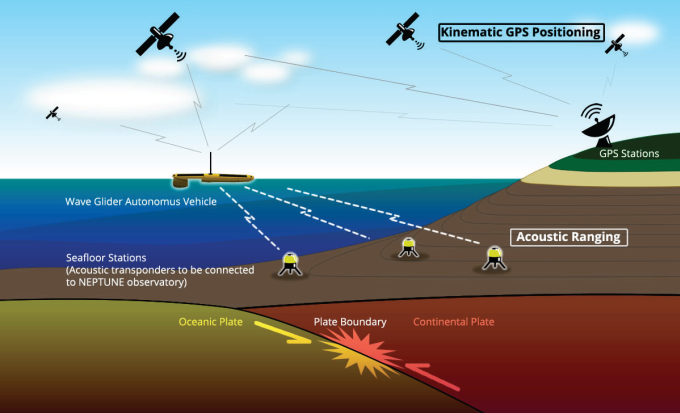Environmental DNA or eDNA is a game-changer in ocean science, making it possible for scientists to monitor ecosystem biodiversity by collecting a small sample of water.
Deployed at Endeavour in 2019, a McLane eDNA phytoplankton sampler was recovered, enabling the first-ever study to understand the important role of protists—single celled animals—in hydrothermal vent ecosystems.
Supported by the Canadian Healthy Oceans Network, PhD student Sheryl Murdock attached special colonizer modules to the sampler that allowed her to produce enough cells in the lab to study their individual genomes, enhancing our understanding of how these life forms are able to survive in the harsh vent environment. Read more about Sheryl’s research.
The Project
Ocean Networks Canada (ONC) has designed a system that utilizes the Wave Glider, an ASV manufactured by Liquid Robotics to gather and transmit data collected by Sonardyne ‘nodes’.
Liquid Robotic’s Wave Glider equipped with acoustic sensors that communicate directly with Sonardyne ‘Nodes’ placed along the Cascadian Subduction Zone will transmit real time acoustic data which will be fetched as the Wave glider passes within proximity of each node. The data collected by the Nodes will then be accessible by the Oceans 2.0 data management system via iridium satellite connections available through ROMOR.

Environmental DNA or eDNA is a game-changer in ocean science, making it possible for scientists to monitor ecosystem biodiversity by collecting a small sample of water.
Deployed at Endeavour in 2019, a McLane eDNA phytoplankton sampler was recovered, enabling the first-ever study to understand the important role of protists—single celled animals—in hydrothermal vent ecosystems.
Supported by the Canadian Healthy Oceans Network, PhD student Sheryl Murdock attached special colonizer modules to the sampler that allowed her to produce enough cells in the lab to study their individual genomes, enhancing our understanding of how these life forms are able to survive in the harsh vent environment. Read more about Sheryl’s research.
The Project
Ocean Networks Canada (ONC) has designed a system that utilizes the Wave Glider, an ASV manufactured by Liquid Robotics to gather and transmit data collected by Sonardyne ‘nodes’.
Liquid Robotic’s Wave Glider equipped with acoustic sensors that communicate directly with Sonardyne ‘Nodes’ placed along the Cascadian Subduction Zone will transmit real time acoustic data which will be fetched as the Wave glider passes within proximity of each node. The data collected by the Nodes will then be accessible by the Oceans 2.0 data management system via iridium satellite connections available through ROMOR.












